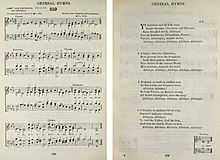Ye Watchers and Ye Holy Ones
| Ye Watchers and Ye Holy Ones | |
|---|---|
 | |
| Genre | Hymn |
| Written | 1906 |
| Text | Athelstan Riley |
| Based on | Psalm 135:1-3 |
| Meter | 8.8.8.8.8.8.8.4 |
| Melody | "Lasst uns erfreuen" |
"Ye Watchers and Ye Holy Ones" (Latin: Vigiles et Sancti) is a popular Christian hymn with text by Athelstan Riley, first published in the English Hymnal (1906). It is sung to the German tune Lasst uns erfreuen (1623).[1][2] Its uplifting melody and repeated "Alleluias" make this a favourite Anglo-Catholic hymn during the Easter season, the Feast of All Saints, and other times of great rejoicing.
The hymn was also notably adapted for the final movement of The Company of Heaven (1937), a cantata by Benjamin Britten.[3]
Text[]
The 1906 text is based on two ancient Eastern Christian prayers, Te Deum and Axion Estin.[1] The first stanza addresses each of the traditional nine choirs of angels. The second stanza focuses on the Blessed Virgin Mary. The third stanza urges the faithful departed to join in praising God, including the church patriarchs, prophets, apostles, martyrs and saints, addressed in groups similar to those in the Litany of the Saints. The fourth stanza finally addresses the present congregation to join together in praise. So, this hymn addresses the traditional Three States of the Church (the Church Triumphant, the Church Expectant, the Church Militant), reflecting the belief in the communion of saints.[4]
The original text follows:[2]
- Ye watchers and ye holy ones,
- Bright Seraphs, Cherubim and Thrones,
- Raise the glad strain, Alleluya!
- Cry out, Dominions, Princedoms, Powers,
- Virtues, Archangels, Angels' choirs,
- Alleluya, Alleluya, Alleluya, Alleluya, Alleluya!
- O higher than the Cherubim,
- More glorious than the Seraphim,
- Lead their praises, Alleluya!
- Thou Bearer of the eternal Word,
- Most gracious, magnify the Lord,
- Alleluya, Alleluya, Alleluya, Alleluya, Alleluya!
- Respond, ye souls in endless rest,
- Ye Patriarchs and Prophets blest,
- Alleluya, Alleluya!
- Ye holy Twelve, ye Martyrs strong,
- All Saints triumphant, raise the song,
- Alleluya, Alleluya, Alleluya, Alleluya, Alleluya!
- O friends, in gladness let us sing,
- Supernal anthems echoing,
- Alleluya, Alleluya!
- To God the Father, God the Son,
- And God the Spirit, Three in One,
- Alleluya, Alleluya, Alleluya, Alleluya, Alleluya!
- Amen.
Melody[]
Below is the 1623 German hymn tune Lasst uns erfreuen, as adapted for the 1906 English Hymnal:[5]
![\header { tagline = ##f }
\score {
\relative
{\key c \major
\time 3/4
\partial 4
\set Score.tempoHideNote = ##t
\tempo 4=96
\override Score.BarNumber #'transparent = ##t
c'4( c8[ d] e[ c] e[ f] g2) c,4( c8[ d] e[ c] e[ f] g2) c8([ b] a4 g) c8([ b] a4
\set Score.tempoHideNote = ##t \tempo 4=48 g\fermata) \set Score.tempoHideNote = ##t \tempo 4=96
\override Score.TimeSignature #'transparent = ##t
\bar "" \break \time 3/4 c( c8[ g] g[ f] e[ f] g2) c4( c8[ g] g[ f] e[ f] g2) f8([ e] d4 c) f8([ e] d4 c)
\bar "" \break \time 3/4 c'8([ b] a4 g) c8([ b] a4 g) f8([ e] d2. c2) \bar "|."
}
\layout { indent = #0 line-width = 150\mm ragged-last = ##t }
\midi {}
}](http://upload.wikimedia.org/score/t/d/tdec09qmfglbqqzqkoq3t82p7nw6771/tdec09qm.png)
References[]
- ^ Jump up to: a b Shomsky, Tiffany. "Ye Watchers and Ye Holy Ones: Worship Notes". Hymnary.org. Retrieved 13 April 2017.
- ^ Jump up to: a b Riley, Athelstan (1906). "519. Ye watchers and ye holy ones". The English Hymnal. Oxford University Press. pp. 672–673. Retrieved 13 April 2017.
- ^ "Britten: The Company of Heaven". AllMusic. Retrieved 16 April 2017.
Sample... XI. Ye watchers and ye holy ones
- ^ Mitchican, Jonathan (1 August 2013). "Ye Watchers and Ye Holy Ones". The Living Church. Retrieved 13 April 2017.
- ^ Wilson, John (Winter 1980). "Treasure No 46: The Tune 'Lasst uns erfreuen' as we know it". Bulletin of the Hymn Society of Great Britain and Ireland. IX.10 (150). Retrieved 13 April 2017.
One of the great successes of The English Hymnal in 1906 was its inclusion of the old German Catholic tune 'Lasst uns erfreuen', linked originally with Easter rejoicing, but now set to 'Ye watchers and ye holy ones', a new text by Athelstan Riley... The EH attribution of the melody was to the book [Auserlesene, Catholische,] Geistliche Kirchengesäng (Cöln, 1623)...
External links[]
- Ye Watchers and Ye Holy Ones, at Cyber Hymnal
- Ye Watchers and Ye Holy Ones, at HymnSite.com
- Ye Watchers and Ye Holy Ones (mp3 with organ only)
- 1906 songs
- 20th-century hymns
- English Christian hymns
- Easter hymns
- Marian hymns
- Christian saints
- Te Deums
- Anglo-Catholicism